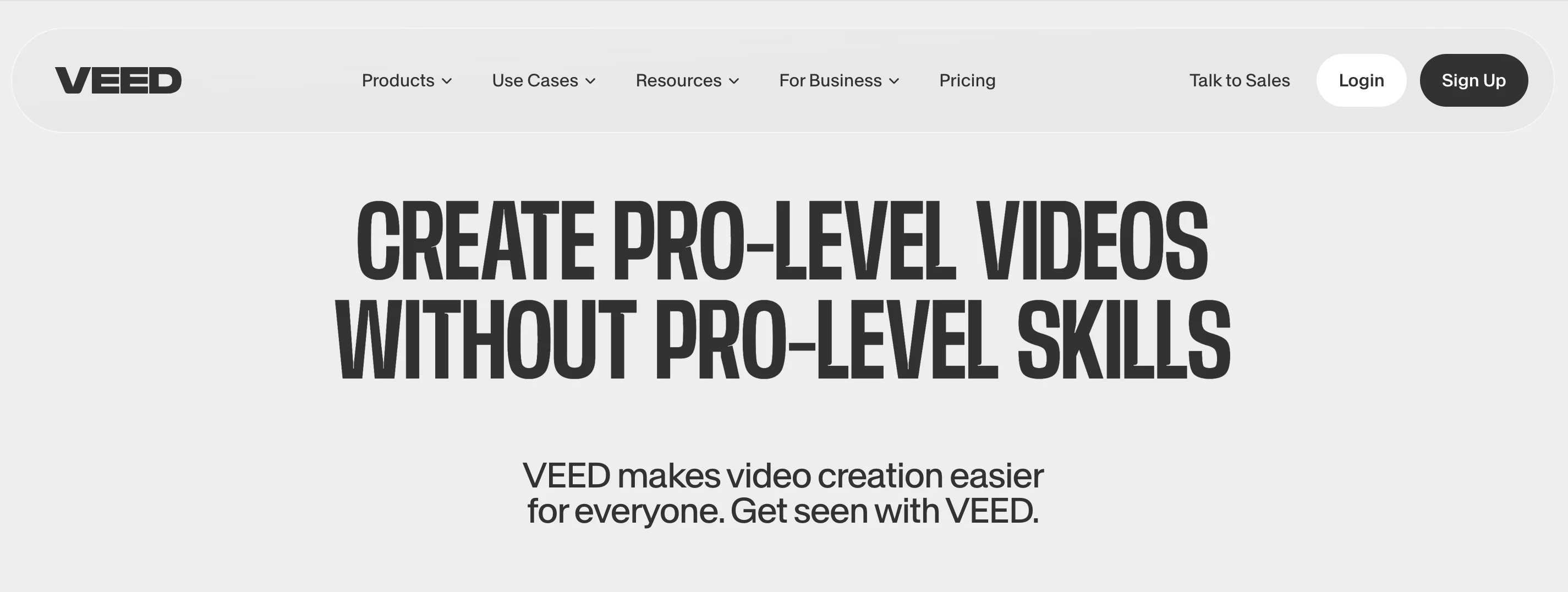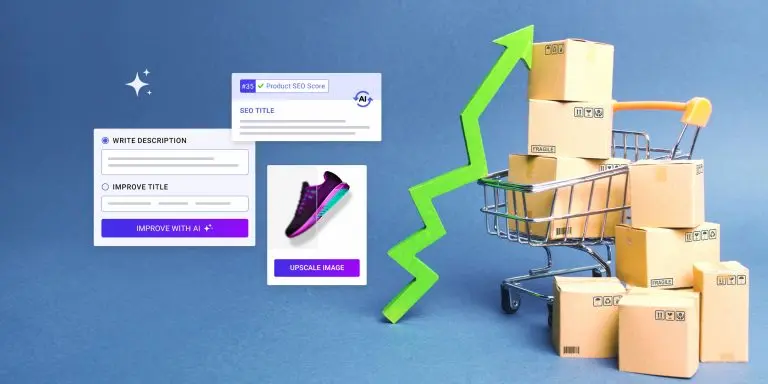Video marketing has evolved from an optional marketing tool to an essential part of any successful business strategy. Especially for dropshipping, where capturing attention quickly and converting browsers into buyers is critical, video marketing plays a crucial role.
Online shoppers are being bombarded by ads, so a great video can stand out as a versatile medium that combines visuals, sound, and storytelling to attract and retain customers.
This guide will walk you through the power of video marketing in dropshipping, along with effective tips and tricks to create high-converting video content.
Table of Contents
Why video marketing is essential for dropshipping
One of the most compelling reasons why video marketing should be a central part of your dropshipping strategy is that it can significantly boost your sales! But there’s more to it than just sales; video marketing is a powerful tool that enhances customer understanding, reduces support queries, and builds a strong connection with your audience.
Here are some statistics that demonstrate the impact of video marketing:
- Boosting product understanding and sales: 88% of video marketers say that videos help users better understand a product or service, and an impressive 87% report that videos have helped them increase sales. When customers can visualize how a product functions or fits into their lives, they’re far more likely to make a purchase. (Source)
- Reducing support queries: Approximately 66% of businesses state that video marketing helps reduce support queries. While video may not solve every issue, it can effectively handle the basics, such as explaining product assembly, answering common questions, and showcasing best practices. This means fewer customer service headaches for you and a smoother experience for your customers. (Source)
- Increasing adoption of video marketing: According to Wyzowl research, 91% of businesses now use video as a marketing tool. This high adoption rate reflects the effectiveness of video across industries, including ecommerce. Video content has become essential for businesses aiming to attract and retain customers in a highly competitive market.
Now, here’s more on why video marketing is especially powerful in the dropshipping world:
- Visual appeal: Dropshipping products often come with fewer touchpoints since customers don’t see the products in person before purchase. Video fills this gap by offering a 360-degree view of the product, highlighting details that photos may miss.
- Building trust and credibility: Authentic, well-produced videos can reassure customers that the product they’re considering is legitimate. When customers see how a product looks, works, and fits into real-life scenarios, they’re more likely to trust your brand.
- Higher engagement rates: Studies show that people are more likely to watch videos than read text, making video content perfect for capturing and retaining attention. Social platforms like Instagram, TikTok, and Facebook are also algorithmically favorable to video content, meaning your video ads are more likely to reach a broader audience.
- Boosting conversions: Engaging videos can drive purchasing decisions, with 82% of people saying they’ve been convinced to buy a product by watching a video. Showing the product in action helps customers envision themselves using it, making the leap from viewer to buyer more natural.
By implementing video marketing, you’re not only adding a dynamic element to your dropshipping store but also creating a channel that builds trust, improves customer satisfaction, and boosts conversions. Whether shared on social media, featured on landing pages, or embedded in product pages, videos allow potential customers to connect with your brand and gain confidence in their buying decisions.
Types of videos to create for your dropshipping business
Creating video content for your dropshipping business doesn’t mean relying on one type of video. Here are some of the top video types to consider:
Product demo videos
Showcasing the product in use gives customers a real understanding of its features and benefits. These videos can be short (like TikToks, Instagram Reels or YouTube Shorts) or longer for a more in-depth overview.
Unboxing videos
Unboxing videos add an element of surprise and authenticity. It’s a raw look at what customers can expect when they receive their order, making them feel like they’re right there with the influencer or reviewer.
Customer testimonials
Customer reviews carry weight, but video testimonials take things a step further by providing authentic, relatable feedback from real customers. You can film customers yourself or share videos that customers submit, making them feel like they’re part of your community.
How-to and tutorial videos
Educating viewers on how to use the product effectively can be a powerful sales tool, especially for products with specific uses or features. This approach builds trust, educates viewers, and reduces return rates by ensuring customers know how to use the product correctly.
Lifestyle videos
Lifestyle videos focus less on the product’s features and more on how it fits into a viewer’s life, adding emotional appeal. Imagine showing your travel gear in exotic locales or your fitness equipment being used in high-energy environments.
Behind-the-scenes content
Giving customers a glimpse of your business’s “human” side helps build brand loyalty. You can show how you source products, create campaigns, or share a day in the life of running your dropshipping business.

Tips and tricks for effective dropshipping video marketing
Now that you know why videos are so important for a successful dropshipping business and the types of videos you can create, let’s look at some key strategies to make sure your video marketing stands out.
1. Keep it short and sweet
Attention spans are short, especially on platforms like TikTok, Instagram, and YouTube Shorts, where quick, engaging content rules. Aim to keep product showcase videos between 15 to 30 seconds long, but ensure each second counts. Focus on visually engaging elements, such as fast transitions, close-ups, and compelling captions to keep viewers hooked.
For longer-form content, like tutorials or unboxing, make sure the opening few seconds are exciting enough to hook viewers. Start with an attention-grabbing visual or teaser of what’s to come to prevent viewers from scrolling past.
2. Showcase product benefits, not just features
While it’s essential to highlight a product’s unique features, the real focus should be on how it improves customers’ lives. For instance, if you’re selling a portable blender, instead of listing specs like blade size or motor speed, demonstrate how quick and easy it is to prepare a smoothie on the go. Show customers the practical, everyday benefits that make your product indispensable.
Consider using a story-based approach. Instead of only displaying the product, create a narrative around it, like a busy professional blending a smoothie between meetings. This resonates on a personal level and builds a stronger connection with viewers.
3. Leverage user-generated content (UGC)
User-generated content is invaluable for dropshipping businesses as it builds credibility. Videos from real customers sharing their experiences and reactions create authenticity, making potential customers more likely to trust your brand. You can feature UGC in your ads, on your product pages, or as testimonials across social media channels.
If UGC isn’t available for you, consider partnering with micro-influencers or offering discounts to customers who share videos of their purchases. Short testimonial videos that capture genuine reactions work especially well for building social proof.
Read more: Leveraging Influencers in Dropshipping: A Comprehensive Guide
4. Experiment with different formats
Video marketing doesn’t stop at simple product showcases. Experimenting with different types of content allows you to reach a broader audience and keep your video strategy fresh. Consider including formats like:
- Tutorials and how-tos: Demonstrate the various ways to use your products, especially if they’re multi-functional.
- Unboxing and first impressions: Capture the excitement of receiving and opening your product, which can create curiosity among potential buyers.
- Behind-the-scenes content: Share insights into the creation or sourcing process, which adds authenticity and builds trust with customers.
- Customer interviews or Q&A sessions: Address common questions directly from customers, positioning your brand as approachable and transparent.
Switching up your formats will prevent monotony and address different audience preferences, which can help increase engagement over time.
5. Optimize for each platform
Each platform has its own culture, audience, and best practices, so it’s crucial to tailor your videos accordingly:
- Instagram and TikTok: Focus on short, vertical videos that are visually stimulating. Use trending music or effects to increase reach and engagement.
- YouTube: Longer, landscape videos perform well here, particularly product reviews, in-depth tutorials, and behind-the-scenes content.
- Facebook: This platform supports a mix of short and long-form content. Test both to see what engages your audience more.
- Pinterest: Eye-catching, vertical videos showcasing lifestyle applications of products tend to perform best on this platform.
Understanding each platform’s unique style will help ensure that your content performs well and reaches the intended audience
6. Use clear calls-to-action (CTAs)
A video without a call-to-action is a missed opportunity. Make sure each video guides viewers on what to do next. For example, if you’re running an ad, you could include CTAs like “Shop Now,” “Learn More,” or “Swipe Up” for Instagram Stories. For organic content, you can add CTAs in your captions or video descriptions, such as, “Want to see more? Follow us for the latest updates.”
On platforms like YouTube, CTAs can prompt viewers to subscribe, check out more videos, or visit your store link in the description. The key is to use CTAs that feel natural and relevant to each platform’s unique style and audience engagement habits.
7. Add text and subtitles
Captions can significantly increase engagement and make your videos accessible to a wider audience, including those who watch videos on mute. They are essential for platforms like Facebook and Instagram, where many users browse without sound.
Adding captions can also benefit users who may not be native speakers of your language or who are watching in a noisy environment. Many video editing apps and social media platforms offer auto-captioning features, making it easy to add captions to each video.
8. Invest in quality (but not too much!)
You don’t need a Hollywood budget for effective dropshipping videos, but clarity, lighting, and good sound make a big difference. Use natural light, avoid shaky footage, and focus on high-quality audio to make your content feel professional. Use a tripod or stabilizer to avoid shaky shots and a simple ring light for good lighting.
Quality production doesn’t necessarily require a high budget. Many smartphones are now capable of capturing professional-grade footage, especially for social media. Investing in affordable tools like a microphone and editing software can also make a substantial difference.
9. Analyze and adjust
Most platforms provide analytics tools that show engagement metrics, view counts, and retention rates for each video. Analyzing this data can help you determine which types of videos perform best, what length keeps viewers’ attention, and which platforms generate the most conversions.
Refine your strategy based on these insights. For example, if unboxing videos have higher engagement than tutorial videos, consider focusing more on unboxings in your future campaigns. Experimenting and adjusting based on real data is the key to continuous improvement.
10. Maintain consistency with posting and branding
Consistency is essential for building a loyal following. Develop a posting schedule to keep your audience engaged and maintain brand awareness. At the same time, ensure your videos have a consistent look and feel that aligns with your brand’s voice, colors, and style.
Consistency in both posting frequency and visual branding establishes a memorable identity for your audience, making it easier for them to recognize your videos in crowded feeds.
Important steps to take when developing a video marketing strategy
Successful video marketing doesn’t happen by chance—it requires a well-thought-out strategy that aligns with your brand’s mission and target audience. Even for short-form content like Instagram Reels or YouTube Shorts, your videos should have a clear purpose. Before creating any video, ask yourself: Who is this video for? What action do I want viewers to take? How will I measure success?
Here are a few key aspects to consider when building a video marketing strategy that drives results.
Understand your audience
Your target audience is the specific group you want to reach with your video content. Ideally, you’ve already defined this audience as part of your broader branding strategy. If not, take time to conduct market research, surveys, or focus groups to build an accurate profile. Knowing your audience’s needs, desires, and challenges is essential for crafting relevant video content.
And keep in mind that audiences differ across platforms. For example, your TikTok followers may prefer quick, catchy videos, while your YouTube audience might expect in-depth content.
Set a budget
High-quality video production can get costly, especially if you’re creating polished brand videos. However, the popularity of low-cost, vertical video formats like TikTok and Instagram Stories offers more affordable options for smaller brands.
If you’re producing a high-visibility brand story for your YouTube channel or website, budget for aspects like talent, production crew, editing, and post-production. Animated videos, on the other hand, may require additional resources like motion designers or illustrators. Be strategic in allocating your budget; assign more funds to high-impact videos that showcase your brand’s identity.
For social media, focus on consistent, engaging short-form content that doesn’t require a hefty production budget but keeps your audience hooked.
Stay within your brand guidelines
Your branding strategy should shape the look and feel of your videos, helping viewers recognize your brand across platforms. To create a cohesive experience, use your brand’s colors, fonts, and style choices through each video.
As you prepare to create content, decide on elements like the music style, video filter, or production team that best matches your brand’s vibe. This consistency not only strengthens brand recognition but also builds a unique, memorable aesthetic.
Set goals
Setting goals is crucial. These objectives give your video marketing efforts direction and purpose. If you’re trying to increase website traffic, encourage social media followers, or grow email subscribers, set specific and measurable targets.
For example, if your goal is to reduce support queries, consider producing explainer videos. Measuring success in this area could be a reduction in support tickets. Each of your goals should correspond directly to a specific outcome, giving you a clear framework for evaluating your strategy.
Define success metrics
Now that you’ve set goals for your video marketing efforts, determine how you’ll measure their success. Use metrics aligned with each campaign, whether that’s engagement rates, follower growth, click-through rates, or conversions.
Experimenting with different formats and content types across platforms will help you determine what works best for your brand. Over time, these insights will allow you to refine your video strategy, tailoring it to meet your audience’s preferences and maximize your marketing ROI.
Tools and resources for dropshipping video marketing
Creating quality video content doesn’t have to be time-consuming or expensive. Here are a few tools to consider:

An easy-to-use mobile video editor with essential features like trimming, merging, and adding music.

Known for graphics, but Canva also has a video editor for basic editing and adding overlays.

A straightforward tool for creating slideshows and short videos perfect for product demos.

Offers an array of video editing tools, from subtitles to text overlays and templates for social media videos.

Great for tutorials and walkthroughs, especially if you want to show product setup or assembly.
Examples of successful dropshipping video marketing campaigns
Let’s take a look at some dropshipping brands that leveraged video marketing effectively and the results they achieved.

BlendJet
BlendJet, a portable blender brand, became wildly successful by using short, engaging video ads across social platforms. They focused on quick demos showing people using their product on the go, highlighting portability, ease of use, and fun colors. The videos reached millions, leading to a boost in brand recognition and sales.
Check out this case study done by YouTube about the BlenJet video strategy

Luxy Hair
Luxy Hair, known for hair extensions, built an entire YouTube channel dedicated to hair tutorials. Instead of pushing their product directly, they provided real value through styling tips and tutorials. This not only established Luxy Hair as an authority in the beauty niche but also generated organic traffic and loyal customers. Check out this podcast for more about their strategy
Fabletics
Fabletics used a mix of testimonials and influencer videos to engage their audience. By combining the credibility of influencers with product reviews, they tapped into both aspirational and authentic appeal, resulting in impressive engagement and higher conversions.
Wrapping up: Video marketing is a must in dropshipping
Incorporating video marketing into your dropshipping strategy can drastically improve your ability to engage and convert customers. From creating quick product demos to leveraging influencer content, video marketing offers endless ways to elevate your brand and connect with potential buyers.
Remember, the key to video marketing is authenticity. Dropshipping doesn’t require enormous budgets or flawless visuals. What it does need is a genuine connection with your audience, showcasing the product’s real value and potential. By combining creativity with strategy, you can tap into the power of video to build a successful and profitable dropshipping business.















